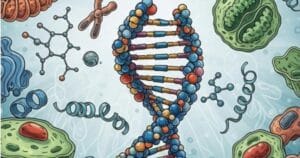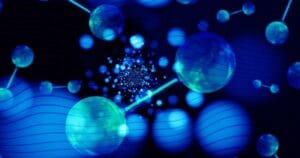
COMPETITIVE EXAM MCQs SERIES of LIFE SCIENCES for UGC-CSIR NET/JRF, SLET, GATE, and other entrance tests – MOLECULES AND THEIR INTERACTION RELEVANT TO BIOLOGY – Molecular Stabilising Forces of Biomolecules.
Syllabus Outline
- Non-covalent interactions – definition and biological significance
- Hydrogen bonding – nature, directionality, role in DNA/protein
- Van der Waals forces – London dispersion, dipole interactions
- Electrostatic (ionic) interactions – salt bridges, charge-charge interactions
- Hydrophobic interactions – entropy-driven, importance in protein folding
- Cation-π and π–π interactions
- Role of these forces in tertiary and quaternary protein structures
- Molecular recognition and ligand binding
- Stabilisation of enzyme-substrate complexes
This quiz contains concept-based, most frequently asked 25 MCQs of “MOLECULES AND THEIR INTERACTION RELEVANT TO BIOLOGY – Molecular Stabilising Forces of Biomolecules”. Each question has a single correct/most appropriate answer.
*****
- What is the main thermodynamic driving force for spontaneous salt bridge formation in water?
A) Enthalpy gain from strong charge attraction overcoming solvation.
B) Entropy gain from reduced dielectric constant.
C) Entropy gain from desolvation and release of ordered water.
D) Low bond energy makes formation easy.Answer: C) - Why are AT-rich regions of DNA less stable than GC-rich regions?
A) GC pairs form stronger π–π stacking.
B) AT pairs form fewer hydrogen bonds.
C) AT pairs have stronger but shorter H-bonds.
D) Stability is the same; stacking dominates.Answer: B) - Which interaction combines ionic and hydrogen bonding to stabilise proteins?
A) Cation–π interaction.
B) Peptide bond.
C) Hydrophobic cluster.
D) Salt bridge.Answer: D) - Arrange the following by bond strength:
I – Van der Waals force of attraction, II – Hydrogen bond, III – Hydrophobic interaction, IV – Ionic bond
A) II ≈ IV > III > I
B) IV > II > III > I
C) I < III < II < IV
D) IV > II > III ≈ IAnswer: B) - What differentiates a Cation–π interaction from a salt bridge thermodynamically?
A) Both are enthalpy-driven.
B) Both are electrostatic.
C) Cation–π is enthalpy-driven; salt bridge is entropy-driven.
D) Cation–π is enthalpy-driven; salt bridge is electrostatic.Answer: D) - Which interaction depends on distance as 1/r⁶ and acts only at a very short range?
A) Ionic.
B) Hydrogen bond.
C) London dispersion.
D) Hydrophobic.Answer: C) - Why is Proline a helix breaker in α-helices?
A) Lacks amide hydrogen for H-bonding.
B) Causes electrostatic repulsion.
C) Has a polar side chain.
D) Too flexible.Answer: A) - Which amino acid favours β-turn formation due to minimal steric hindrance?
A) Glycine
B) Alanine
C) Valine
D) PhenylalanineAnswer: A) - Protein folding from random coil to native state is mainly driven by:
A) Enthalpy
B) Hydrophobic effect
C) Salt bridge formation
D) H-bond energyAnswer: B) - The Levinthal paradox shows that protein folding is:
A) Slow driven by entropy
B) Fast driven by enthalpy
C) Guided by folding pathways
D) Driven by hydrogen bondingAnswer: C) - In enzymes, induced fit primarily enhances:
A) Enthalpic stabilisation
B) Entropic gain
C) Transition-state complementarity
D) Product releaseAnswer: C) - Which bond rotation defines the backbone conformation of proteins?
A) ψ and χ
B) φ and ψ
C) ω and χ
D) φ and ωAnswer: B) - Which region of the Ramachandran plot is most restricted?
A) Glycine region
B) Alanine region
C) Proline region
D) Serine regionAnswer: C) - In proteins, tertiary structure is primarily stabilised by:
A) Covalent peptide bonds
B) Non-covalent interactions
C) Backbone hydrogen bonds
D) Salt bridgeAnswer: B) - Which pair of amino acids most often participates in salt bridges?
A) Asp–Lys
B) Ser–Thr
C) Gly–Ala
D) Tyr–TrpAnswer: A) - The hydrophobic effect in folding primarily arises from:
A) Strong attraction among nonpolar groups
B) Release of ordered water
C) Covalent cross-linking
D) Charge neutralisationAnswer: B) - Circular dichroism spectroscopy helps in determining:
A) Amino acid sequence
B) Secondary structure composition
C) Protein charge
D) Quaternary assemblyAnswer: B) - β-mercaptoethanol is used in protein refolding studies to:
A) Break disulfide bonds
B) Stabilise hydrophobic core
C) Enhance folding rate
D) Block ionisationAnswer: A) - Chaperonins assist protein folding by:
A) Catalysing peptide bond formation
B) Preventing aggregation
C) Breaking misfolded proteins
D) Forming covalent cross-linksAnswer: B) - Which amino acid is most likely to be found in the core of a globular protein?
A) Serine
B) Alanine
C) Leucine
D) AspartateAnswer: C) - Why are aromatic residues often found near cationic residues?
A) π-electron clouds stabilise cations.
B) Form hydrogen bonds.
C) Neutralise charge.
D) Form salt bridges.
Answer: A - Which factor best explains entropy–enthalpy compensation in biomolecular binding?
A) Loss of conformational freedom offset by new interactions
B) Loss of covalent bond with new non-covalent interactions
C) Randomness of solvent by new interactions
D) Ionic repulsion by charge reversal due to intermolecular interactionsAnswer: A) - The “hydrophobic collapse” model describes folding as:
A) Sequential hydrophobic bond rotation
B) Aggregation of nonpolar residues forming a compact core
C) Random chain expansion with hydrophobic interactions
D) Tertiary structure breakdown by excess hydrophobic interactionsAnswer: B) - Which amino acid strongly absorbs UV at 280 nm?
A) Tryptophan
B) Tyrosine
C) Phenylalanine
D) HistidineAnswer: A) - The β-sheet twist is mainly due to:
A) Electrostatic repulsion and Steric interference of side chains
B) Backbone chirality and hydrogen bond geometry
C) Electrostatic repulsion and Hydrophobic packing
D) Hydrophobic packing and Steric interference of side chainsAnswer: B)
*****
Previous: Biomolecules Structure and Key Functions
Next:
References
- Nelson, David L. & Cox, Michael M. (2021). Lehninger Principles of Biochemistry, W. H. Freeman, 8th Edition
- Voet, Donald, Voet, Judith G., & Pratt, Charlotte W. (2018). Voet’s Principles of Biochemistry, Wiley, 5th Edition
- Berg, Jeremy M., Tymoczko, John L., & Stryer, Lubert (2023). Biochemistry, W. H. Freeman, 10th Edition
- Palmer, Trevor & Bonner, Philip L. (2007). Enzymes: Biochemistry, Biotechnology, Clinical Chemistry, Horwood Publishing, 2nd Edition
- Upadhyay, Avinash, Upadhyay, K., & Nath, Nirmalendu (2023). Biophysical Chemistry: Principles and Techniques, Himalaya Publishing House, 4th Edition

